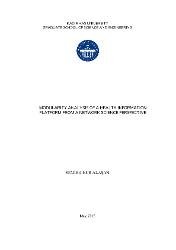| dc.contributor.advisor | Aydın, Mehmet Nafiz | en_US |
| dc.contributor.author | Alaşan, Semiha Nur | |
| dc.date.accessioned | 2020-06-23T10:54:52Z | en_US |
| dc.date.available | 2020-06-23T10:54:52Z | en_US |
| dc.date.issued | 2015 | en_US |
| dc.identifier.uri | https://hdl.handle.net/20.500.12469/2948 | |
| dc.description.abstract | As Barabási (2015) emphasizes that the very idea of communities goes back to the time people were born into communities and had to find their individuality. But today it is the other way around, that is, people are born individuals and have to find their communities. This research is aimed to better understand modularity measures for a health information platform. Such platform is an exemplary of its many kinds that are characterized as interactive, web-based information exchange platforms. These platforms draw attentions of academics due to its underlying complex systems behavior in various domains such as computer science, management science, sociology, and management information systems (MIS). We adopt a perspective of an emerging interdisciplinary field called network science that enables us to analyze modularity of a health information platform. The whole connection network normally has 2143 nodes and 5706 edges. In this research, since the modularity is examined, it is vague to integrate the sprinkled nodes over the giant component. Thus and so, the only giant component having 1652 nodes and 5146 edges is studied. This analysis is based on the modularity maximization algorithm, which Gephi uses as default, by assigning two different resolution values for the same data set to try which resolution value gives better results. | en_US |
| dc.description.abstract | Barabási'nin (2015) de değindiği gibi eskiden insanlar bir topluluk içine doğup sonradan bireyselleşmeye çalışırken, günümüzde insanlar bireysel olarak doğup bir topluluk içine dahil olmaya çalışıyorlar. Bu çalışma, sağlık bilgi platformundaki modül (modularity) analizini yapıp gruplaşmayı modül kriterleri açısından incelemeyi amaçlıyor. Bu platform, bilgi alışverişinin sağlandığı interaktif webtabanlı birçok platforma emsal teşkil ediyor. Bu platformlar, altında yatan karmaşık sistem davranışları sebebiyle akademisyenlerin dikkatini çekip bilgisayar bilimleri, yönetim bilimi, sosyoloji ve yönetim bilişim sistemleri ihtisaslarında incelemeye değer bulunuyor. Ağ bilimi olarak adlandırılan gelişmekte olan disiplinlerarası alanı bakış açısını benimseyerek sağlık bilgi platformunda modül analizi yaptık. Modül analizinde dev bileşenin etrafında yer alan bağımsız düğümleri incelemek anlamsız olacağından normalde 2143 düğüm (node) ve 5706 bağa (edge) sahip olan bağlantı ağının 1652 düğüm ve 5146 bağdan oluşan dev bileşeni (giant component) ele alındı. Bu analiz, aynı veriseti için iki farklı "resolution" değeri atanıp hangi "resolution" değerinin daha iyi sonuçlar verdiğini anlayabilmek için Gephi adlı yazılımın default olarak kullandığı "modül maksimizasyonu" (modularity maximization) algoritması baz alınarak yapıldı. | en_US |
| dc.language.iso | eng | en_US |
| dc.publisher | Kadir Has Üniversitesi | en_US |
| dc.rights | info:eu-repo/semantics/openAccess | en_US |
| dc.subject | Social Network Analysis | en_US |
| dc.subject | Modularity Analysis | en_US |
| dc.subject | Resolution Limits | en_US |
| dc.subject | Online Health Information Platform | en_US |
| dc.subject | Sosyal Ağ Analizi | en_US |
| dc.subject | Modül Analizi | en_US |
| dc.subject | "Resolution" limitleri | en_US |
| dc.subject | Online Sağlık Bilgi Platformu | en_US |
| dc.title | Modularity analysis of a health information platform from a network science perspective | en_US |
| dc.type | masterThesis | en_US |
| dc.department | Enstitüler, Lisansüstü Eğitim Enstitüsü, İşletme Ana Bilim Dalı | en_US |
| dc.relation.publicationcategory | Tez | en_US |
| dc.identifier.yoktezid | 392380 | en_US |
















